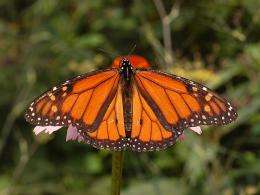Wing design proves a key factor in determining migration success of Monarch butterflies

Each fall, millions of monarch butterflies make a spectacular journey from the eastern parts of North America to reach their overwintering grounds in Mexico. Researchers have long known that not all butterflies successfully reach their destination. Now scientists from the University of Georgia, in Athens, provide some crucial answers on what it takes for Monarchs to complete the trip. It turns out - it's all in the wings!
In the article "Variation in wing characteristics of monarch butterflies during migration" published earlier this month in Animal Migration, Dara A. Satterfield and Andrew K. Davis describe for the first time a close link between migration timing and optimal wing design in the migratory butterfly. They discovered that monarchs that fall behind in the migration (and which might not survive) tend to have wings with less-than-ideal designs.
The paper, which appears in the open access journal, by De Gruyter Open, analyzes how the size, shape and color of the wings differ among a collection of migrant monarch butterflies. While prior studies have examined how monarch wing size varies within a migratory season, this study went beyond to include specific measures of wing shape and color that were obtained using fine-scale computer software.
The findings provide answers to one long-standing question regarding monarch migration - that is, why do some monarchs survive the migration and not others?
The researchers captured monarch butterflies as they migrated through northern Georgia (USA) in the fall of 2010. Each monarch was scanned with a flatbed scanner to produce a digital copy of their wings. Computer software was then used to measure features of the wings, such as the size, shape and shade of orange pigmentation. This information was compared for monarchs that were captured early against those captured late in the migration.
The results of this project showed that early migrants not only tend to have larger wings, but they are also more elongated - both of which are features that promote long-distance migration. Early monarchs also tended to have redder wing colors. This conclusion is consistent with the prior work, which has shown that monarchs with redder wings tend to fly farther. For monarchs, the degree of redness is therefore an indicator of superior flight performance.
The monarchs that migrated the latest were likely to be small, have less elongated and paler wings, suggesting that these features slow down the migratory pace. These stragglers presumably fell behind in the migratory race. In fact, some monarchs migrated so late that they probably failed to reach their overwintering destination.
This paper provides evidence of the importance of optimal wing characteristics for migration. So far, this trait has been demonstrated in connection with migratory birds, but as far the monarch butterflies are concerned, it appears to be novel. According to the authors, the earliest migrants have the highest chance of success in reaching the winter home, and these monarchs should be prioritized for scientific studies and for conservation purposes.
More information: Paper: www.degruyter.com/view/j/ami.2 … 01/ami-2014-0001.xml
Provided by De Gruyter Open

















